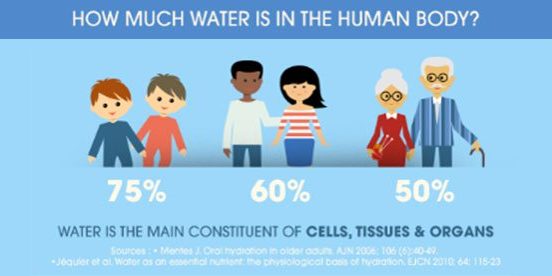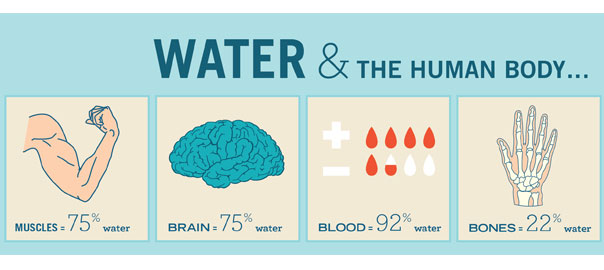How much water we have in our bodies?
Up to 60% of the human adult body is water. According to H.H. Mitchell, Journal of Biological Chemistry 158, the brain and heart are 73% water. And the lungs are about 83%. The skin contains 64%, muscles and kidneys are 79%, and even the bones are watery: 31%.
Have you ever wondered how much of your body is water? The percentage of it varies according to your age and gender. Here’s a look at how much water is inside you. The amount of it in the human body ranges from 50-75%. The average adult human body is 50-65% water, averaging around 57-60%. The percentage of it in infants is much higher, typically around 75-78%, dropping to 65% by one year of age.
Who Has the Most Water?
Babies and children have the highest percentage.
Adult men contain the next highest level.
Adult women contain a lower percentage than babies or men.
Obese men and women have less, as a percentage than lean adults.
The percent of water depends on your hydration level. People feel thirsty when they have already lost around 2-3% of their body’s water.
 Where Exactly Is Water in the Human Body?
Where Exactly Is Water in the Human Body?
Most of the body’s water is in the intracellular fluid (2/3 of the body’s water). The other third is in the extracellular fluid (1/3 of the water).
What Is the Function of Water in the Body?
Water serves multiple purposes:
The primary building block of cells. It acts as an insulator, regulating internal body temperature. This is partly because water has high specific heat. And the body uses perspiration and respiration to regulate temperature. It is needed to metabolize proteins and carbohydrates used as food. It is the primary component of saliva. We used it to digest carbohydrates and aid in swallowing food.
The compound lubricates joints. It insulates the brain, spinal cord, organs, and fetus. It acts as a shock absorber. Used in flushing waste and toxins from the body via urine. The principal solvent in the body. It dissolves minerals, soluble vitamins, and certain nutrients. It also carries oxygen and nutrients to cells.
The function of body fluid:
The water we drink is absorbed by the intestines, and circulated throughout the body. It will be in the form of body fluids such as blood. These perform various functions that keep us alive. They deliver oxygen and nutrients to the cells. And take away waste materials, which are then eliminated with urination. When the body temperature rises, blood circulation to the skin increases. It then enables heat dissipation though sweating. It helps the body to keep at a constant temperature.
The human body’s major component
The water in our body is found in two main locations, in our cells (two-thirds) and outside our cells (one-third).
The body of a 70-kg man contains about 42L of water – 28L intracellular and 14L extracellular, of which:
3L is blood plasma;
1L is the transcellular fluid (cerebrospinal fluid, ocular, pleural, peritoneal and synovial fluids);
10L is the interstitial fluid (including lymph)
an aqueous medium surrounding the cells(1).
The amount of water in the human body varies according to age. The body of a newborn, for example, is composed of more water (75%) than that of an elderly person (50%).
Also, the more muscular a body is, the more it contains. The more fat there is in the body, the less will be present.
So, as you can see, water is life!








